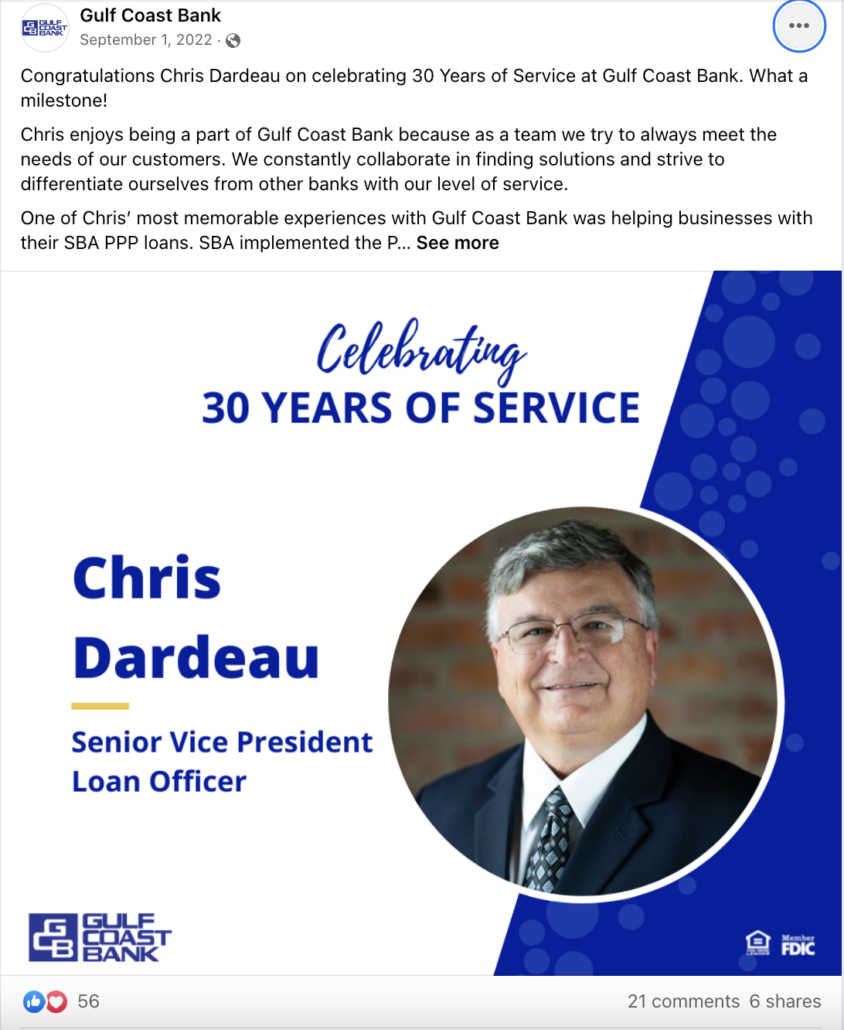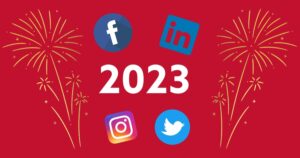Social media can get a bit of a bad rap. Next to other, perhaps easier-to-manage marketing channels like email, your website, mailers, and sponsorships, it can be tough to know the right amount of time and resources to invest in social. Which channels should you be on? How often should you post? What should you be talking about? How do you know if you’re succeeding?
The reality is that a consistent, focused social media presence is incredibly important—especially for community-focused organizations with local, relationship-driven customer bases. In short, social is crucial for community banks, credit unions, and financial brands, and 2023 is the year to amp it up. Here’s why.
1. It helps build credibility.
Social media has become one of the first places people look when they’re researching a product, brand, or company. The stats say social media is a major source of information on what to buy for 43% of internet users, and as many as 75% of users report using social media to research products and services.
What does that mean for community banks, credit unions, and financial brands? It means new and existing customers who see your brand at major events, attached to community work, paired with nonprofit partners, on billboards, and in local ads are likely to look you up on social media and draw conclusions about your products and services, your people, and your organization as a whole. First, be sure folks find a legitimate social presence and secondly, the content they find there amplifies your credibility and reinforces who you are and what you do.

2. It fosters community connection.
Many members of your community are spending literal hours of their days on social media—making it a good place to engage individuals and tap into their networks. Tagging is a great way to invite customers, partners, and other community members into an online conversation, which can then influence how your social posts are served up and to whom— garnering more and more engagement as people respond.
Supporting an upcoming event? Be sure to share it on social and tag the organization(s) you’re supporting through the event. Proud of a nonprofit partnership or ongoing commitment to serving a local community group? Post about it and tag them. Tagging locations can also be helpful; it fosters connections with local community businesses by helping them garner more exposure and also influences the algorithms to serve up relevant content to people in the area.
3. Social followings have huge value.
As you start to grow your following (i.e. the number of followers your social pages have), you can begin to translate that into value. Indeed, when you have hundreds or thousands of people actively interested in seeing the information you’re putting out on a regular basis, there are tons of opportunities to ensure content moves the needle. But the first step is to start and build a following.
"The bottom line is that social media is an advertising channel worth investing in."
4. Social exposure can be targeted and strategic.
It’s common to think about social media as a strictly organic avenue for exposure, but the reality is that paid social media advertising can be incredibly lucrative. You can target social media audiences in a number of ways depending on the platform you’re using, including by demographics as granular as job title and interests. Paid social can include both paid social media placements (i.e. ads) and organic posts that are boosted or promoted to increase exposure to specific audiences.
The bottom line is that social media is an advertising channel worth investing in. If you’re unsure how to get started and what to expect, start with a small budget and some key metrics like engagement, click through rate (i.e. traffic to your website on posts that link back to longer-form content), and page follows. Be sure to invite everyone who engages with your content to follow your page, and do some experimenting with both organic and paid content to see what moves the needle for your audience.
5. Gen Z is definitely on social.
How are you engaging and attracting younger audiences to your products and services? It’s a crucial question and one that’s especially top of mind for community banks and credit unions. The reality is that Gen Z (and millennials for that matter) are spending quite a lot of time on social media. In fact, an Adobe study concluded that social media is the advertising channel considered most relevant for a whopping 50% of Gen Zers and 42% of millennials!

A couple pro tips: Be helpful by offering insights and information. Gen Zers are especially interested in informative content about financial best practices, investing, and money management. They’re eager to hear from brands who share this information in an authentic and easily digestible way. Consider a short video series or a recurring blog that breaks down a seemingly complicated topic like interest rates or inflation. With this content living on your website, you can then use social media posts to promote your longer-form pieces and drive traffic back to your website.

6. There’s a unique personal element.
Brands can use social media in a way that’s fundamentally more personal than perhaps any other marketing channel. This is a game-changer for relationship-driven products and services, including home loans, small business loans, wealth management, and private banking. Here, lenders, sales agents, and business development professionals can use social media more strategically–sharing more personal updates in a way that builds their personal brand while also benefiting the bank or credit union as a whole.
As marketing teams look for ways to empower lenders and sales agents through systems, processes, and technology that allows sales agents to post on social in a way that’s compliant and on-brand. This might also include libraries of pre-approved or templated content for a grab-and-go experience, or workflows that integrate approvals from marketing and/or compliance teams. The point is to ensure lenders and sales agents are empowered to engage with their communities and new and existing customers consistently and authentically through social channels in an efficient and on-brand fashion.
7. Social can tie into other marketing channels and KPIs.
It’s no secret that people are spending more time on social media than they will spend on your website (or any website, for that matter). Having a consistent and engaging social media presence lets you use that to your advantage. Consider how social channels can be used to produce other marketing results, namely website traffic and lead generation. Indeed, 75% of marketers credit social media with increased web traffic, and almost 90% say it has improved business exposure. What’s more, of those who have used social media marketing for two years or more, 50% report increased sales.
So, how can you execute? Start by setting goals around website traffic and share content from your website on social media in a way that drives traffic. For example, you might post a captivating story about the people and vision behind a small business loan that turned into a successful enterprise on your website’s blog. Be sure to include a call to action at the end of the story about small business loans, creating an opportunity for a conversion. Then look for ways to promote the story across other channels—in your customer newsletter, for example, and certainly on social. Think like a journalist here: Create an enticing headline and a short, snappy intro that piques the readers’ interest so they stop scrolling and click to read the whole piece. When this marketing funnel is executed at every step, social media becomes not only a place to share updates about community service work and financial tips, but a way to convert exposure into tangible website traffic and leads.
8. Social media campaigns can drive specific outcomes.
Speaking of aligning social with specific KPIs and marketing results, campaigns are an ideal way to do it. What, exactly, is a social media campaign? It’s a focused initiative that occurs over a series of posts and updates on one or more social channels—all aimed at a specific theme. Campaigns should be simple and fun, so they’re focused on generating buzz and engaging the community. Remember: You can invite those who engage with your (Facebook) posts to like (and follow) your page, which in turn increases your following and creates an increasingly larger captive audience over time.
If you’re not sure where to start on a social media campaign, Social Assurance can help. We run campaigns large and small for community banks, credit unions, and financial brands all over the country, building them around themes ranging from holiday-themed photo contests to large-scale give-back initiatives.
9. It can help with employee engagement and recruiting.
Social media is a particularly great way to recognize employees, including specific moments and acts of service, promotions and new hires, interns and up-and-coming talent, and tenured employees. This creates a cyclical effect, wherein employees feel recognized and proud of the work they do and the people they serve. At the same time, new and existing customers see the human element of your organization and experience a familiarity with staff that helps everyone build trust more quickly and effectively.
Employee-related social media posts don’t have to be complicated. Consider a quick, couple-question interview with one of your lenders, or perhaps a mini-spotlight on a teller or frontline employee. Show off some recent design work from an intern, or highlight an employee who works closely with nonprofits and community organizations. Track work anniversaries and put out recurring posts that congratulate long-term employees on their years or decades of service. As part of your planning, save time by slating in an employee-related post at least once a month and creating a standard template for the way it’s designed.

10. It’s easier than you might think.
If the thought of maintaining another channel or presence feels a bit overwhelming, know that you’re not alone. It’s not uncommon for community banks, credit unions, and financial brands to outsource all or some of their social media workload. This might include simple tasks like content planning, copywriting, and design, or bigger, more strategic work like campaign buildout and execution, launching a presence on a new platform, and bigger-picture strategic content work that ties social to other channels and KPIs.
Whatever your need, Social Assurance is here to help. We work with financial brands and service providers all over the country interested in taking their social presence to the next level. Contact us at info@socialassurance.com or follow the link below to learn more.


